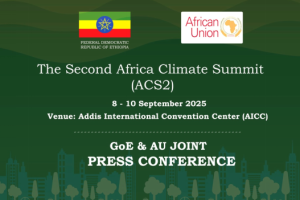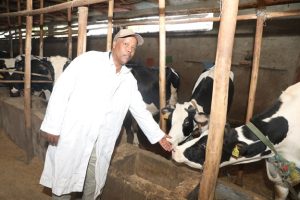BY HAFTU GEBREZGABIHER
For a third round now, Ethiopia is bracing for its annual massive afforestation campaign where by billions of tree seedlings are transplanted in all corners. The massive campaign aims to combat environmental degradation and keep Ethiopia as the water tower of Africa. The campaign is part of the Green Legacy Initiative, promoted by Prime Minister Abiy Ahmed to reach national green environmental goals and face the effects of deforestation and climate change in the country.
The Ministry of Agriculture, the Ministry of Innovation and Technology, local governments, officials and operators of public institutions, schools and private companies, NGOs and associations of different sectors have joined the campaign. But it is above all the population of the country that has made it possible to achieve a result of such great impact.
Most of the seedlings distributed to the participants and planted are from indigenous tree species and a nationwide monitoring will be conducted to ensure that the planted trees would be grown.
The promoters of the initiative and the national and international press have given great emphasis to the results of this campaign and to the new record set by Ethiopia. The last record-breaking environmental campaign has been realized in 2017 by India, where around 1.5 million volunteers planted more than 66 million trees in 12 hours.
Reforestation initiatives are not new in a country like Ethiopia that has actively participated in the Billion Tree Campaign, an extraordinary competition for a greener world promoted by the United Nations. Ethiopia ranks third in planting trees in the framework of this Campaign launched in 2006 by the United Nations Environment Program and inspired by the Nobel Peace Prize Wangari Maathai, founder of the Green Belt Movement in Kenya.
Ethiopia joined the Top 10 countries including China, India, Pakistan, Mexico, France, Turkey, Peru, Nigeria, Kenya, Egypt and United States through the green legacy initiative, according to Wikipedia.
The potential for irrigation and water supply, design of water engineering structures and watershed development programs can all be based on past patterns of hydrological and meteorological variables. Water resources are being exploited at an alarming rate in many areas of the world including the Abay Basin of Ethiopia.
The Abay Basin delivers more than 85 percent of the River Nile water to Aswan, Egypt. The basin is also home to 20 million inhabitants whose main livelihood is subsistence agriculture (Population Census Commission 2008). The hydrological records of the Abay Basin form a key basis for dimensioning hydraulic structures such as dams, as well as transboundary negotiations about the sharing of the basin water resources (FAO 2000), and the assessment of the sustainability of subsistence farming systems in the region.
This farming is mainly dependent on rain, with some additional small-scale irrigation using streams. The subsistence farming is the main form of livelihood for 80 percent of the population, and the population this farming must support has been increasing at an annual rate of 2.6 percent during 1990–2000 (Population Census Commission 2008).
Political changes in relation to land management are suggested to worsen the availability of water resources in the Abay Basin, according to the Ministry of Water Resources. The political change in 1974/1975 with the overthrow of the monarchy was accompanied by a ‘‘land to the tiller’’ policy, where many previously uncultivated lands were allocated for cultivation. There was a nationwide resettlement campaign during 1984/1985 before another political regime change in 1991. After that point, a new and more secure land tenure system called ‘‘rural land registration’’ was implemented. This encouraged farmers to clear forests in some areas and plant trees in other areas, especially around homesteads.
The changes in land management policies caused degradation of soil, forest and other natural resources. In addition, there is a continuous soil degradation associated with land use change in the region. These changes also assumed to exacerbate the water scarcity. A common assumption is that when forest lands, which could help the infiltration of water, were removed or degraded, the capacity of the land to retain water decrease.
This leads to increased run-off during the rainy season and reduced run-off during the dry season. However, this assumption has often not been confirmed by data, especially on large-scale watersheds (100 km2), and continues to be debated. It is examined hydrological records of 32 watersheds from 1960 to 1963 and concluded that there are spatial patterns in the hydrological regime of the Abay tributaries related to land use and geology.
Forty-five years of hydrological data from 12 watersheds in the Abay Basin, Ethiopia, were tested for possible trends over the entire time series and differences in medians (step-wise changes) between three sub-periods.
The majority of the significant changes were watershed specific. Run-off coefficient was the single variable showing a consistently increasing trend and stood for about 25 percent of the total significant trends and step-wise changes. Half of these changes occurred after 1991.
It is recalled that despite the land use policy changes in 1975 and 1991, as well as the long-term soil degradation, the hydrological regime was quite stable over the 45-year period, with the exception of an increase in the run-off coefficient in the latter part of the run-off record in some watersheds, according to various findings underwent by the above stated institutions.
As maintaining the annual water volume and flow of the country is a matter of survival, the effective implementation of the green legacy initiative also plays a big role to this end. Since many of Ethiopia’s river basins are also transboundary, the green legacy initiative directly or indirectly plays vital role in ensuring the water security of neighboring countries.
The Ethiopian Herald July 2021




